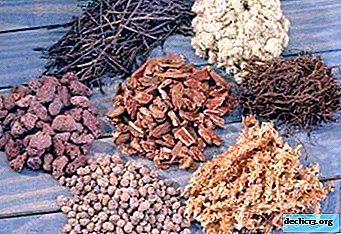What flowers look like a money tree? Description and photos of plants

Fans of indoor flora, the fat girl with its pleasant looking fleshy leaves appreciated a long time. No wonder: the plant is very attractive. A tree with a green crown of thick shiny leaves in the sun.
Moreover - modest in needs. If there is already a fat woman, then often there is a desire to acquire a collection of plants similar to her.
What kind of flowers are similar to it, what are they called and what features do they have - we will consider in this article.
Name, description and photo of indoor flowers that resemble a fat girl
Crassula (Crassula, money tree) - succulent plant. It makes moisture reserves in its tissues, as it grows in dry places. Therefore, the leaves of Crassuli are not thin, but dense, thick. They store water supplies. Of course, succulents of other species are similar to a fat woman. Their world is vast and interesting. However, there are also non-succulent plants, which are sometimes confused with fat women.
If you had an idea to plant a whole garden of such flowers on the windowsill, you can pick up an interesting set of plants that are similar in some nuances to the grass.
Ficus
Ficus (Ficus) is an unfading classic of indoor floriculture. Even in pre-revolutionary times, these powerful plants in tubs decorated apartments, houses and offices. Ficuses belong to the Mulberry family.
These plants are not succulent. However, they have large leaves, which creates a decorative effect. This ficus resembles a fat girl. In addition, they are similar in their absolute unpretentiousness. If there is no time for constant fuss with indoor flowers, then ficus, like rossula, is an ideal choice.
The most popular indoor varieties of this plant.

Rubber-bearing (F.elastica)
The plant is large, with very large leathery green leaves. It differs from the sun-loving fat girl in that it tolerates content well in relative shadow. Such a tree in a large capacity can be placed in the back of the room: It will decorate your home and feel great. Daylight should be enough, but the ficus does not make too serious requirements for this.

Benjamina (F. benjamina)
This plant is small, the leaves are thinner and of a different shape than that of the rubbery leaves. There are varieties with variegated leaves, very decorative.

Kalanchoe
Kalanhoe (Kalanchoe or Kalanchoe) - a common plant for the homeMoreover, with medicinal properties. This genus is the closest relatives of Crassul, also belong to the Tolstyankov family. Kalanchoe is a genus that includes a large number of very different species.
They look different. Basically, these are grassy shrubs, some modern varieties bloom luxuriously (this is in contrast to the grassroots). The similarity is found in rather large (in most species) leathery leaves (not as fleshy as in the fat women). Unpretentiousness - in stock, as in the red.
Besides, Kalanchoe, like a fat woman, has an interesting method of reproduction. Small new plantlets grow immediately on the branches of the Crassula with roots (take and plant in the ground). Kalanchoe is still more interesting. The so-called brood buds grow along the edges of the leaves. Such buds with roots either fall to the ground themselves and take root, or they can be carefully broken off and planted in the soil. Soon get a new adult plant. Zamioculcas.

Zamioculcas (dollar or euro tree)
Zamioculcas (Zamioculcas) is a plant that is credited with modern beliefs as the ability to improve the welfare of the owners. Hence the popular name - “dollar” or “euro tree”. If the fat girl is just a "money tree", then zamioculcas (or caladium) is referred to more specifically and elegantly. The plant in the room culture is new (appeared only at the beginning of the 21st century), so the name was invented to him here is so modern.
This “euro” tree really resembles a fat girl, it is large, has slightly elongated oval leaves similar to the redgrass, thick stems. The plant belongs to the Aroid family. It differs from the fatty also in a tuberous large root. It is the plant itself that is decorative: the flowers, like those of the crassulas, are not of particular interest.
Attention! Zamioculcas - a toxic plant, has a very burning juice. You should work with him in gloves, avoid splashing the juice on the mucous membranes, eyes, hands.In this photo you can see the photo of Zamioculcas:

Aptenia (Aptenia)
Aptenia (Aptenia) is a very charming evergreen plant from the Aisov or Mezembriantem family. This succulent has bright green leaves resembling hearts.
The plant itself is grassy, with juicy stems. Shoots can really resemble a young, immature fat girl. However stems of aptenia do not lignify. Unpretentious succulent blooms with very lovely lilac-red flowers, also quite decorative.

Eonium (Aeonium)
Aeonium (Eonium) is a very interesting representative of the Tolstyankov family. A close relative of Crassula, however, has an absolutely distinctive appearance. In different varieties and species, fleshy leaves - of various colors (from pale green with pinkish - then dark purple, almost black) are collected in rosettes of various shapes. They resemble a "stone rose" and other similar plants. Stunningly decorative look.
Some species have a powerful tree trunk, like a familiar crassula. Exotic!

Peperomia (Peperomia)
Peperomia (Peperomia) - a popular indoor flower from the pepper family. Although a relative of Crassula is not, but, for example, peperomia dupus is very reminiscent of a fat woman. Similar in shape to the back-ovate leaves, dense stems, in general - a beautiful, decorative, lush bush.
However, there are a lot of types of peperomia, and they can be very different from ovate crassula. For example, ferreira peperomia has elongated lanceolate leaves. In peperomia, dolabriformis, the leaves are also elongated, folded as if by a boat, two-tone (from the bottom - very light, from above - pale green). There are more exotic representatives of the genus. Hutchison's peperomia has pink spotted leaves and at first glance it raises the question - is this a terrestrial plant in general?
Reference! Peperomia is not classified as an “unkillable” plant, unlike the fat women. They are quite capricious, demanding for moderate but regular watering, for diffuse lighting, etc. However, their diversity and beauty attract experienced gardeners.If you still want to pick plants that are similar to a fat girl (crassula, money tree), then you need to look in the direction of succulents. Many of them feel great in room culture, they are easy to get and just keep. Very interesting plants of the genus.

Hoya
Hoya (Hoya) - this is the most popular indoor creepers from the Dovnevy family. These plants are also called "wax ivy." Varieties are countless, it is interesting to collect a collection. The leaves are large and leathery, like in the red. However, the plants themselves are ampelous, with thin flexible stems and mesmerizing, like wax, flowers gathered in dense umbrellas. Each variety has a different flowering.
There are unpretentious varieties, there are more capricious and requiring experienced hands. You can choose a variety of hoya to your liking. One is unlikely to stop!

It is worth paying close attention also to eheveria, graptopetalum, slipway and many other genera of succulents.
As you can see plants that look like a fat girl (crassula, money tree) in appearance or unpretentiousness, a lot. We have listed only a tiny fraction of the diversity of families and genera that can cause your interest. Succulents are impressive, fascinating and may well become a favorite hobby for life!

















